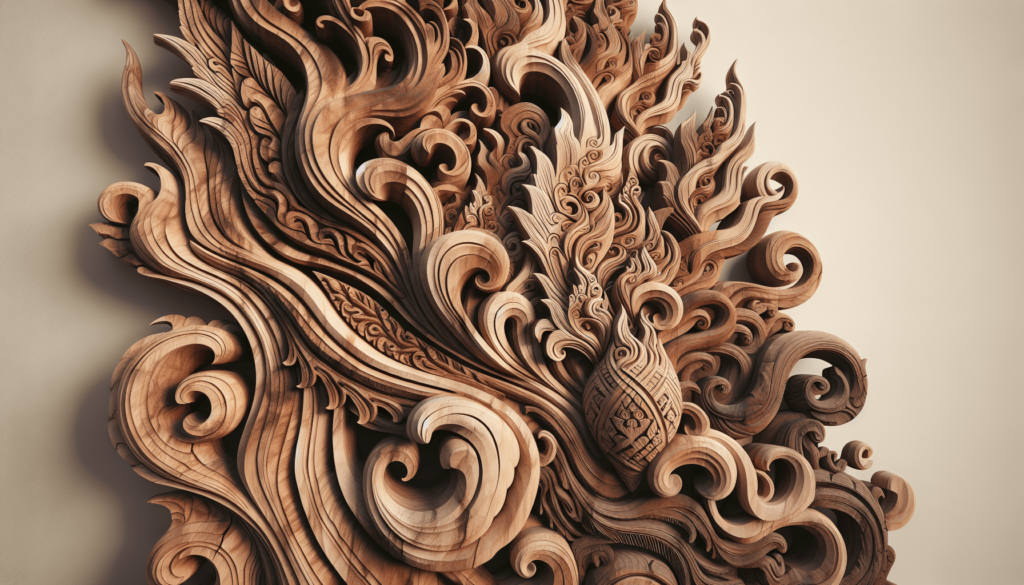Have you ever found yourself staring at a beautifully carved wooden sculpture, wondering what the official name for this kind of art might be? Maybe it was an intricately designed chair, or perhaps it was a stunning piece of wall art made from a finely polished plank. Whatever it was, you’re probably curious about the terminology and artistry behind it. So, let’s chat about it.
What Is Art Made of Wood Called?
Art made of wood goes by many names and can take on even more forms. At its most basic, the term you’re likely looking for is “woodworking” or “wood art.” This includes everything from simple carved figures to intricate, large-scale installations. The world of wood art is vast, fascinating, and full of history.
Woodworking vs. Wood Art
You might wonder about the difference between woodworking and wood art. Woodworking typically refers to the crafting of functional items. Think furniture, cabinetry, and tools. On the other hand, wood art leans more toward creating items for visual appreciation—you know, making something that makes you say, “Wow, that’s cool,” even if you have no idea what it is or does.
The History of Wood Art
Wood art dates back thousands of years, making it one of the most ancient forms of artistic expression. Before fancy chisels and varnishes, early humans probably used bone or rock tools to carve out rudimentary figures from trees. Over time, techniques advanced, and what started as basic carvings evolved into the sophisticated, artful pieces we admire today.
Types of Wood Used in Wood Art
The variety of wood used in wood art is as broad as the types of art themselves. Different woods offer different textures, colors, and durability, impacting the final piece’s look and lifespan.
Here’s a table to make it easy to understand:
| Wood Type | Characteristics | Common Uses in Wood Art |
|---|---|---|
| Oak | Strong, durable, coarse texture | Furniture, large sculptures |
| Pine | Soft, easy to carve, not very durable | Small carvings, decorative items |
| Mahogany | Rich color, smooth texture, durable | High-end furniture, intricate sculptures |
| Maple | Hard, smooth finish, light color | Cutting boards, fine furniture, musical instruments |
| Ebony | Very hard, deep black, expensive | Fine details, luxury items, inlays |
Techniques Used in Wood Art
Creating wood art is no small feat. There’s a range of techniques artisans employ to transform a simple chunk of wood into a stunning work of art.
Carving
Carving is perhaps the most straightforward and common technique. It involves removing parts of the wood to create shapes. There are different styles of carving, including:
- Whittling: Usually involves a pocket knife and is the simplest form of carving.
- Chip Carving: Uses chisels to remove small chips of wood to create intricate designs.
- Relief Carving: Creates images that protrude from a flat background.
Turning
Turning is another popular technique, often used to create symmetrical objects like bowls, spindles, and vases. This involves mounting the wood on a lathe and shaping it as it spins. Imagine pushing a blunt ax on a spinning log for hours on end—sort of like that, but more refined.
Pyrography
Want to add a bit more flair? Pyrography, or wood burning, involves using a heated tool to burn designs into the wood. It’s like drawing, but with fire—so you can imagine how careful you have to be. It’s a technique that requires a steady hand and a lot of patience.

Famous Wood Artists
You might think of wood art as a simple hobby or just furniture-making, but many artists have elevated it to a fine art form. Some of these artists have achieved international acclaim.
Grinling Gibbons
Grinling Gibbons was a Dutch-British sculptor who specialized in wood and stone carving. His work primarily consisted of decorative elements for cathedrals and large estates. Known for his incredibly intricate floral designs, Gibbons’ wood carvings are nothing short of mesmerizing.
Wharton Esherick
Often regarded as the “dean of American craftsmen,” Wharton Esherick was an artist who transitioned from painting to sculpture and eventually to furniture making. His designs are considered to be foundational in the Studio Furniture Movement, and his works are celebrated for their organic, flowing lines.
Ernst Gamperl
A contemporary marvel, Ernst Gamperl is a German artist known for his turned wooden vessels. He often starts with discarded wood pieces, allowing their natural shapes and flaws to guide his artistic process. His work focuses on embracing the imperfections of wood, symbolizing the interaction between man and nature.
Cultural Significance of Wood Art
Wood art isn’t just pretty to look at; it often carries significant cultural weight. In various cultures around the world, wood art serves a multitude of purposes, from the practical to the deeply spiritual.
African Wood Art
In many African cultures, wood art is not just decorative but also functional and ceremonial. Masks, statues, and even furniture may hold religious and cultural significance. Each piece often tells a story or represents spiritual beliefs, such as ancestral worship or protective spirits.
Native American Wood Art
Native American tribes have a rich tradition of wooden art, especially in the Pacific Northwest. Totem poles, masks, and carvings are often imbued with spiritual meaning and used in rituals and ceremonies.
Asian Wood Art
From the delicate woodblock prints of Japan to ornate Chinese calligraphy panels, wood art in Asia has a long and storied history. In Japan, for instance, wood carving was essential for temple architecture, while Chinese artisans employed it in elaborate furniture and decoration.

Practical Applications of Wood Art
While it’s easy to get lost in the aesthetics of wood art, let’s not forget that it also has a slew of practical applications. Beyond admiration, wood art serves functional purposes in our daily lives.
Furniture
The most straightforward application of wood art is in furniture-making. Beyond simple, utilitarian designs, many pieces are crafted as works of art in their own right. Think of a carefully sculpted chair that’s not only comfortable to sit in but also a conversation starter.
Architectural Elements
Wood art also finds its way into structural design. Balustrades, handrails, and even entire facades can be intricately designed and carved, blending function with form in the most elegant ways. It’s architecture meeting art, marrying usability with beauty.
Everyday Utensils
From wooden spoons to bowls, the mundane items in our kitchen that we often take for granted can also be considered wood art. Artisans who dedicate their craft to these everyday items make sure that each piece stands out, turning the act of cooking or eating into a more pleasurable experience.
How to Appreciate Wood Art
You don’t have to be an expert to appreciate wood art; sometimes you just need a different perspective. Here are some tips to enjoy and understand it better.
Understanding the Material
Knowing a bit about the types of wood and their characteristics can deepen your appreciation. For instance, understanding that ebony is rare and very hard makes you value a finely detailed ebony carving even more.
Recognizing the Technique
Once you know the various techniques—carving, turning, pyrography—you can look at a piece of wood art and better appreciate the skill and time it took to create it. It’s like recognizing brush strokes in a painting; the more you know, the more you see.
Cultural Context
Understanding the cultural background of a piece can add layers to your appreciation. Knowing that a particular mask is not just a decorative item but a sacred object used in rituals can significantly alter how you view it.
How to Start Creating Wood Art
Feeling inspired? Maybe you want to dip your toes into the world of wood art. Here are some steps to get you started.
Gather Tools
Depending on what you want to do, you’ll need some basic tools. For carving, a set of chisels and a mallet will suffice. If you’re interested in turning, investing in a lathe is essential. Pyrography will require a wood-burning kit. Start simple and expand as your skills grow.
Select Your Wood
Choose the right wood for your project. Pine is excellent for beginners because it’s soft and easy to carve. As you gain experience, you can move on to harder woods like oak or maple.
Learn the Skills
There are abundant resources available to learn wood art techniques. Online tutorials, local workshops, and even books can help you get started. The key is to practice, practice, and practice some more.
Start Small
Don’t jump into creating a giant sculpture on your first go. Start with small projects—like a carved ornament or a turned bowl—before moving on to larger, more complex pieces.
Keeping the Craft Alive
Wood art is not just a relic of the past; it’s very much alive and evolving. Many modern artists are pushing the boundaries of what can be done with wood, blending traditional techniques with contemporary designs.
Modern Innovations
With technology such as CNC machines and laser cutters, wood art is leaping into the 21st century. These tools enable precision and complexity that were previously unimaginable, opening up entirely new avenues for artistic expression.
Sustainable Practices
In today’s world, sustainability is crucial. More artists are now sourcing their wood responsibly, using reclaimed or salvaged wood to create their pieces. This counters the negative impact of deforestation, making the art form more eco-friendly.
Community and Sharing
The internet provides a platform for wood artists to share their work, techniques, and tips. Communities on platforms like Reddit, Instagram, and specialized woodworking forums have brought together enthusiasts and professionals from around the world. This sharing culture helps keep the craft alive, ensuring that techniques are passed down and innovations are celebrated.
Final Thoughts
Art made of wood, often casually referred to as woodworking or wood art, encompasses a range of techniques, materials, and cultural significances. From the ancient carvings that adorn our museums to the modern innovations gracing art galleries, wood art represents centuries of human ingenuity and creativity.
Whether you’re an admirer, an aspiring artist, or someone looking to appreciate the subtle details of a handcrafted wooden piece, there’s something deeply enriching about understanding the history, techniques, and cultural significance of this form of art. So, next time you see a beautifully crafted wooden object, you’ll not only know what to call it but also the rich story it likely carries within its grain.

